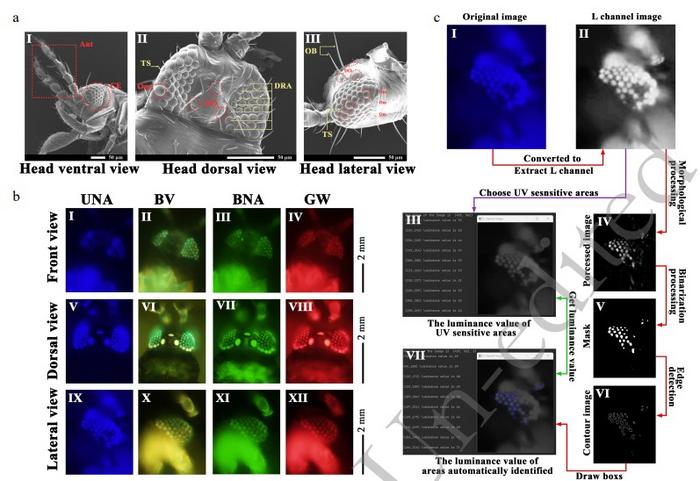A research team founded that field populations of the thrips Megalurothrips usitatus and Thrips palmi in China have developed high resistance to multiple insecticides, presenting significant control challenges. By utilizing ultraviolet-absorbing film in greenhouses (Uva-FG), they achieved over 96% control efficiency and increased crop yields for cowpea and Hami melon. This research highlights the potential of leveraging thrips’ visual systems as an environmentally friendly control method, laying the foundation for future applications in sustainable agriculture.

Credit: The authors
A research team founded that field populations of the thrips Megalurothrips usitatus and Thrips palmi in China have developed high resistance to multiple insecticides, presenting significant control challenges. By utilizing ultraviolet-absorbing film in greenhouses (Uva-FG), they achieved over 96% control efficiency and increased crop yields for cowpea and Hami melon. This research highlights the potential of leveraging thrips’ visual systems as an environmentally friendly control method, laying the foundation for future applications in sustainable agriculture.
In China, cowpea cultivation has a long history, primarily in temperate and tropical areas, but faces significant threats from thrips, which damage crops by feeding on young plant parts. Despite various management measures, chemical agents remain the most used control method, leading to high resistance levels in thrips populations. Currently, Megalurothrips usitatus and Thrips palmi exhibit notable resistance to commonly used insecticides, highlighting the need for innovative control methods.
A study (DOI: 10.48130/tp-0024-0014) published in Tropical Plants on 13 May 2024, aims to explore the effectiveness of ultraviolet-absorbing film (UVa-F) in controlling high-resistant thrips in greenhouses.
To evaluate resistance in M. usitatus and T. palmi, insecticide surveys were conducted in Haikou and Sanya regions from 2021 to 2023, assessing susceptibility to pyrethroids, neonicotinoids, spinetoram, and emamectin-benzoate. Results indicated a significant increase in resistance to pyrethroids in both thrips species. Neonicotinoid resistance in Haikou declined, whereas Sanya showed an upward trend. Emamectin-benzoate resistance showed a modest decline in Sanya, while resistance to spinetoram and emamectin-benzoate continued to rise. Additionally, numerous mutations were identified in the sodium channels and nicotinic acetylcholine receptors of these thrips, with high-frequency mutations potentially contributing to resistance. To address these challenges, the effectiveness of UVa-F in greenhouses was tested, revealing significant thrips population reduction and improved crop yields. The UVa-FG showed a 96.67% and 97.69% control rate for M. usitatus and T. palmi, respectively, with an increase rate in crop yield of 22.5% and 14.3% for cowpea and Hami melon yields. Further analysis of thrips’ compound eyes under UVa-F treatment indicated specific ommatidia responses to UV light, suggesting a visual mechanism behind the control efficacy of UVa-F.
According to the study’s lead researcher, Shaoying Wu, “The mechanisms that the thrips use to respond to UV lights and adapt to environmental changes were explored in this study by the analyses of the compound eye structure and vision-related genes in thrips. The upregulation of the vision-related genes was demonstrated under UV light conditions. This study lays a foundation for its field application Evaluation.”
In summary, this study monitored the resistance of M. usitatus and T. palmi to different insecticides and created a UVa-F for greenhouse application. Analysis of the compound eyes of M. usitatus revealed specific light-sensitive regions and upregulated opsin genes under UV light. Further exploration of thrips’ visual mechanisms and UV response could enhance sustainable pest control, decrease insecticide use, and hinder resistance development, ultimately enhancing agricultural practices and crop quality.
This work was supported by Hainan Major Science and Technology Project (ZDKJ2021007), National Key Research and Development Program of China (2022YFD1401200 and 2022YFD1400900), Hainan Province Key Research and Development Project (ZDYF2021XDNY190), The Project of Sanya Yazhou Bay Science and Technology City (SCKJ-JYRC-2023-15) and The 111 project (grand no. D20024).
###
References
DOI
Original Source URL
https://doi.org/10.48130/tp-0024-0014
Authors
Fen Li, Haifeng Jin, Zhiye Yao, Limin Xian, Kaiyang Liu, Likui Wang, kun Zhang, Xiaobin Shi, Wayne Jiang, Shaoying Wu
Affiliations
1.School of Breeding and Multiplication (Sanya Institute of Breeding and Multiplication), Hainan University, Sanya, 572025, China
2.School of Information and Communication Engineering, Hainan University, Haikou, 570228, China
3.School of Tropical Agriculture and Forestry, Hainan University, Danzhou, 571737, China
4.Institute of Plant Protection, Hunan Academy of Agricultural Sciences, Changsha, 410125, China
5.Department of Entomology, Michigan State University, 48824, East Lansing, MI, USA
6.Department of Entomology, College of Plant Protection and Sanya Institute of China Agricultural University, Beijing, China
# Authors contributed equally: Fen Li, Haifeng Jin, Zhiye Yao, Limin Xian
About Tropical Plants
Tropical Plants (e-ISSN 2833-9851) is the official journal of Hainan University and published by Maximum Academic Press. Tropical Plants undergoes rigorous peer review and is published in open-access format to enable swift dissemination of research findings, facilitate exchange of academic knowledge and encourage academic discourse on innovative technologies and issues emerging in tropical plant research.
Journal
Tropical Plants
Method of Research
Experimental study
Subject of Research
Not applicable
Article Title
A new optical practice as an effective alternative to insecticides for controlling highly resistant thrips
Article Publication Date
13-May-2024
COI Statement
The authors declare that they have no competing interests.



